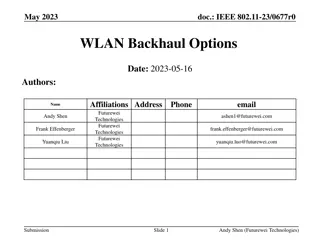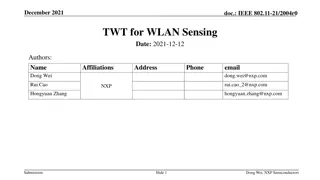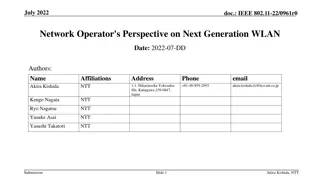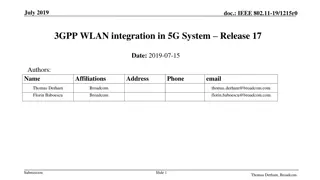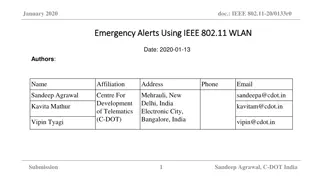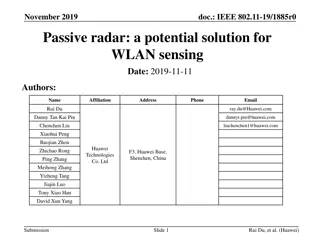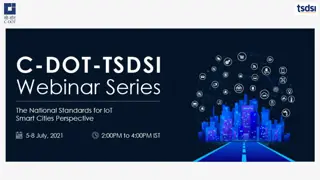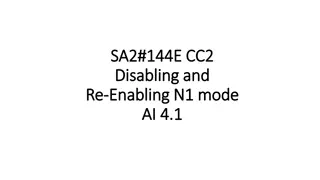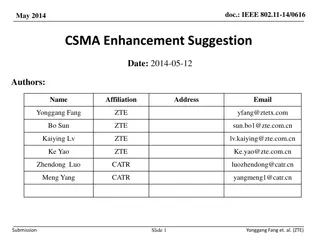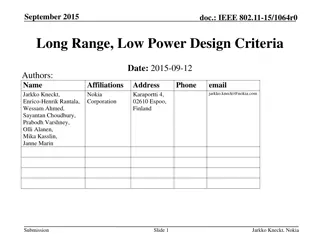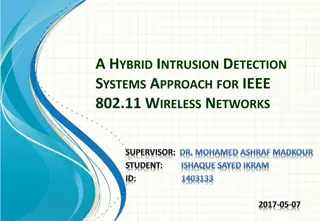Proposed Way Forward for WLAN/5G Interworking Report
The document discusses objections to a technical report on WLAN/5G interworking within the IEEE 802.11 Working Group, highlighting inaccuracies and lack of detail. Rejected comments point out misunderstandings and shortcomings in defining interworking functionalities between WLAN and 5G as per 3GPP standards. It emphasizes the need for clear and accurate technical information to enable successful interworking between WLAN and 5G networks.
Download Presentation

Please find below an Image/Link to download the presentation.
The content on the website is provided AS IS for your information and personal use only. It may not be sold, licensed, or shared on other websites without obtaining consent from the author. Download presentation by click this link. If you encounter any issues during the download, it is possible that the publisher has removed the file from their server.
E N D
Presentation Transcript
March 2021 doc.: IEEE 802.11-21/0438r0 WLAN/5G interworking report Proposed Way Forward Date: 2021-03-10 Authors: Name Robert Stacey Affiliations Intel Address Phone email robert.stacey@intel.com Submission Slide 1 Robert Stacey, Intel
March 2021 doc.: IEEE 802.11-21/0438r0 Abstract At the January 2021 802.11 closing plenary a motion to approve 20/0013r13 the Draft technical report on interworking between 3GPP 5G network & WLAN failed I opposed and would like to provide more detail on the arguments I made at the time I would also like to propose a way forward Submission Slide 2 Robert Stacey, Intel
March 2021 doc.: IEEE 802.11-21/0438r0 Specific objections (1) The report s introduction makes the following statement: This technical report provides an overview of the IEEE 802.11 Working Group s understanding of Wireless Local Area Network (WLAN), based on IEEE Std 802.11, interworking with the 3rd Generation Partnership Project (3GPP) 5th Generation (5G) core network. As a member of the 802.11, it does not represent my understanding of 3GPP/WLAN interworking It is light on detail It is inaccurate Similar comments made during comment collection were rejected Based on the reject reasoning, it appears that there is insufficient interest in fixing the problems Submission Slide 3 Robert Stacey, Intel
March 2021 doc.: IEEE 802.11-21/0438r0 Rejected comments Comment Proposed Change Resolution Notes This technical report does not accurately reflect 5G and WLAN interworking as defined in 3GPP. It is misguided in terms of the new functionality being asked to be added in the WLAN STA and AP to support interworking. Significant discussions were held during several AANI SC teleconferences and several related contributions were discussed: 11-20/1472r0, 11-20/1376r0 and 11-20/1031r0. However, no specific text changes to 11-20/0013r5 were proposed. Also note, a motion made to approve 11-20/1376r0 as the baseline for the technical report failed and the AANI SC agreed to proceed with comment resolution using 11-20/0013 as the baseline (see minutes: 11-20/1512r1). The comment fails to identify changes in sufficient detail so that the specific wording of the changes that will satisfy the commenter can be determined. It is difficult to understand the report and how to use it to enable the support for interworking with 5G within the WLAN domain. This technical report has several inaccuracies, misinformation and missing details on the WLAN and 5G interworking as defined by 3GPP in Release 15 and 16. There is major lack of technical accuracy and technical clarity in section 3 and 4. The report is misleading in terms of what functions need to be supported within WLAN to enable interworking. The set of new functions/protocols identified in section 5 to be implemented within WLAN do not accurately represent what needs to be supported in WLAN to enable interworking and are quite misleading. See comment. Reject Significant discussions were held during several AANI SC teleconferences and several related contributions were discussed: 11-20/1472r0, 11-20/1376r0 and 11-20/1031r0. However, no specific text changes to 11-20/0013r5 were proposed. Also note, a motion made to approve 11-20/1376r0 as the baseline for the technical report failed and the AANI SC agreed to proceed with comment resolution using 11-20/0013 as the baseline (see minutes: 11-20/1512r1). The comment fails to identify changes in sufficient detail so that the specific wording of the changes that will satisfy the commenter can be determined. Overall, due to the technical inaccuracies as well as misinformed and misguided nature of the report, this technical report does not serve the purpose of providing a reliable reference for stakeholder/groups interested in enabling WLAN interworking with 5G networks. Reject Significant discussions were held during several AANI SC teleconferences and several related contributions were discussed: 11-20/1472r0, 11-20/1376r0 and 11-20/1031r0. However, no specific text changes to 11-20/0013r5 were proposed. Also note, a motion made to approve 11-20/1376r0 as the baseline for the technical report failed and the AANI SC agreed to proceed with comment resolution using 11-20/0013 as the baseline (see minutes: 11-20/1512r1). The comment fails to identify changes in sufficient detail so that the specific wording of the changes that will satisfy the commenter can be determined. The comment submitter will provide a separate submission on the 5G and WLAN interworking. Reject Significant discussions were held during several AANI SC teleconferences and several related contributions were discussed: 11-20/1472r0, 11-20/1376r0 and 11-20/1031r0. However, no specific text changes to 11-20/0013r5 were proposed. Also note, a motion made to approve 11-20/1376r0 as the baseline for the technical report failed and the AANI SC agreed to proceed with comment resolution using 11-20/0013 as the baseline (see minutes: 11-20/1512r1). The comment fails to identify changes in sufficient detail so that the specific wording of the changes that will satisfy the commenter can be determined. This document has too many issues and misleading information on overall WLAN & 5G integration options, architectures and solutions. It would be very confusing and concerning to publish such a report. Also, please note that there is a paralel related "5G & WLAN RAN Convergenge" work at WBA. It is important that we are aware of what is already happening in this space rather than proposing something disregarding them. Do not publish it unless it is radically re-written and aligned with the other work in this space. More discussion/contributions needed to fix the inaccuracies specifically wrt TSN architectures shown in the paper are required. Reject Significant discussions were held during several AANI SC teleconferences and several related contributions were discussed: 11-20/1472r0, 11-20/1376r0 and 11-20/1031r0. However, no specific text changes to 11-20/0013r5 were proposed. Also note, a motion made to approve 11-20/1376r0 as the baseline for the technical report failed and the AANI SC agreed to proceed with comment resolution using 11-20/0013 as the baseline (see minutes: 11-20/1512r1). The comment fails to identify changes in sufficient detail so that the specific wording of the changes that will satisfy the commenter can be determined. There are several inaccuracies and misinformation in this technical report related to WLAN integration and interworking with 5G. The TSN architecture as shown for the 5G and WLAN converged network and also for the WLAN only network is incorrect. The recommendations made at the end of the report do not accurately represent what is needed to enable interworking Reject Submission Slide 4 Robert Stacey, Intel
March 2021 doc.: IEEE 802.11-21/0438r0 Specific objections (2) I question the value of the report as an 802.11 WG document As a tutorial it is less informative than material available elsewhere, e.g., 20/1579r0 IEEE 802.11 and 3GPP 5G System Interworking 21/0408r0 5G and Wi-Fi RAN Convergence The gap analysis is not comprehensive and lacks detail The gap analysis in 20/1579r0 and 21/0408r0 covers all the topics in this report and provides more detail It is inaccurate and misleading in certain areas, e.g., 3GPP Rel 15/16 does not define tightly coupled & loosely coupled interworking model shown in Figure 2 & 3. Figure 3 shows TNGF as part of loosely coupled model, however TNGF requires tight integration with WLAN over Ta, but N3IWF does not. Section 4.2: A STA terminal shall initially support registration and authentication to establish a connection between a STA terminal and N3IWF is inaccurate. Registration and auth are not done to establish connection with N3IWF. Section 6.1: NAS signaling to AMF and packet session control to SMF are specified in 3GPP specifications and can be implemented in STA TEC and WLAN ANC. is inaccurate. WLAN access network does not implement NAS signaling and packet session related control. Section 7: The STA TEC and WLAN ANC should contain the function for NAS signaling, ATSSS and QoS management functions, and should follow the guidance of the 3GPP specifications. is inaccurate. NAS Signaling and ATSSS are not supported by WLAN access network. Submission Slide 5 Robert Stacey, Intel
March 2021 doc.: IEEE 802.11-21/0438r0 Proposed Way Forward Acknowledge the work done by the authors of this report It has raised awareness in 802.11 on an important topic It has stimulated debate and engaged individuals that typically don t participate in 802.11 However, do not give this document more weight than other input to 802.11 It is primarily the work of its authors 802.11 should use this document (as a contribution from its authors) together with other input (e.g., previously cited material) to motivate for change in the one document that matters: the 802.11 standard We should encourage, individuals to get together and debate specific topics But we should make decisions on technical change in the appropriate project (e.g., TGme, TGbe) E.g., ARC and the What is an ESS? topic. A group of individuals got together, debated a specific topic and came up with a set of changes that they will bring as a proposal to TGme Submission Slide 6 Robert Stacey, Intel





